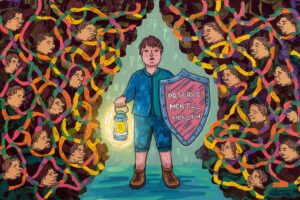How to Preserve Your Mental Health from Toxic Relationship Patterns?
Preserving your mental health is essential for overall well-being, and toxic relationship patterns can significantly impact your emotional and psychological stability.
Recognizing and addressing these patterns is crucial for maintaining healthy relationships and protecting your mental health.
In this article, we will explore strategies and techniques to identify toxic relationship dynamics, establish boundaries, practice self-care, seek support, cultivate emotional awareness, break free from codependency, and build resilience. By implementing these tools, you can safeguard your mental health and create healthier, more fulfilling relationships.

Table of Contents
ToggleDefining Toxic Relationship Patterns
Toxic relationships are characterized by patterns of behavior that are harmful and destructive to one or both parties involved. These patterns can manifest in a variety of ways, including but not limited to emotional manipulation, verbal abuse, and physical violence.
Identifying and defining toxic relationship patterns is crucial in order to break free from the cycle of abuse and create healthier, more fulfilling dynamics in one’s relationships.
Common signs of toxic relationship patterns include a lack of respect, communication breakdowns, and a dynamic of power and control.
It is important to recognize these patterns early on and take steps to address them through therapy, setting boundaries, or seeking support from friends and family.
By understanding and defining toxic relationship patterns, individuals can make empowered choices in their relationships and work towards creating a more positive and fulfilling life for themselves.
Read more about “What is The Role of Cognitive Behavioral Therapy in Sustainable Weight Loss?”
How to Recognize Toxic Relationship Patterns?
Recognizing toxic relationship patterns is imperative in maintaining healthy and fulfilling interpersonal connections. One common red flag to watch out for is a lack of trust and respect in the relationship. This can manifest in various forms such as constant lying, manipulation, or disregard for personal boundaries.
Additionally, patterns of emotional or physical abuse should never be tolerated in a healthy relationship. These toxic behaviors can lead to feelings of inadequacy, anxiety, and depression in one or both parties involved.
Another toxic relationship pattern to be aware of is gaslighting, which is a form of psychological manipulation that seeks to make the victim doubt their own sanity.

Gaslighting may involve belittling, invalidating feelings, or shifting blame onto the victim. It is essential to be mindful of these behaviors and address them promptly to prevent further harm.
Overall, recognizing toxic relationship patterns requires introspection, open communication, and the willingness to set boundaries and seek help when needed. By being attuned to these warning signs, individuals can cultivate relationships that are supportive, respectful, and empowering.
Read more about “How to Recognize Toxic Patterns in Your Relationship and Ways to Overcome?”
The Impact of Toxic Relationships Patterns on mental health
Toxic relationship patterns can have a profound impact on an individual’s mental health. These relationships are characterized by manipulation, emotional abuse, and controlling behaviors that can erode a person’s self-esteem and sense of self-worth.
Constant exposure to toxic relationships can lead to symptoms of anxiety, depression, and low self-esteem. Individuals may experience feelings of worthlessness and helplessness, as well as a sense of being trapped in a cycle of abuse and manipulation.

Furthermore, toxic relationships can also have long-term effects on mental health, leading to conditions such as post-traumatic stress disorder (PTSD) and complex trauma.
Individuals may develop coping mechanisms such as dissociation or numbing in order to protect themselves from the emotional pain caused by these relationships.
This can impact their ability to form healthy relationships in the future, as well as their overall mental well-being. It is important for individuals in toxic relationships to seek support from mental health professionals in order to heal from the emotional wounds caused by these toxic patterns and establish healthier boundaries in their relationships.
Read more about “5 Common Causes of Rhabdomyolysis and How to Avoid Them”
How to Identify Common Signs of Toxic Relationships?
Toxic relationships can be detrimental to one’s mental and emotional well-being, and it is crucial to be able to identify common signs of toxicity in order to protect oneself from potential harm.
One red flag to look out for is a lack of respect in the relationship. This can manifest in various ways, such as belittling comments, dismissive behavior, or outright disrespect towards opinions and boundaries.
Another sign of a toxic relationship is being constantly subjected to manipulation and control. This can include gaslighting, guilt-tripping, and using emotional blackmail to maintain power and dominance in the relationship. By recognizing these signs, individuals can begin to address and potentially extricate themselves from toxic relationships.
Furthermore, another indicator of a toxic relationship is a pervasive feeling of negativity and drain on one’s energy and happiness.

Constant criticism, pessimism, and a general sense of unease can signal that the relationship is not healthy and may be causing more harm than good.
It is important to also pay attention to how one feels when around the other person – if there is a consistent sense of unease, anxiety, or feeling drained after interactions, it may be a sign that the relationship is toxic.
By being aware of these signs and acknowledging the impact they have on one’s well-being, individuals can take steps to remove themselves from toxic relationships and prioritize their own mental and emotional health.
Symptoms of Toxic Relationship
Toxic relationships can manifest in various ways, with subtle signs that may not be immediately recognizable. One of the key symptoms of a toxic relationship is emotional manipulation.
This can take the form of gaslighting, where one partner denies the feelings or experiences of the other, causing the victim to doubt their own reality. Another common symptom is a lack of communication or constant conflict.

In a toxic relationship, communication may be diminished or hostile, leading to frequent arguments and misunderstandings. This can create a cycle of negativity and erode the bond between partners.
Additionally, a toxic relationship may also exhibit signs of control and possessiveness. One partner may try to exert power over the other, dictating their actions, relationships, or even appearance.
This can lead to feelings of suffocation and a loss of autonomy for the victim. Furthermore, in a toxic relationship, there may be a lack of respect and support between partners, with one partner constantly belittling or undermining the other.
These behaviors can be damaging to one’s self-esteem and overall well-being. In short, it is crucial to recognize the symptoms of a toxic relationship in order to address and overcome the underlying issues for the benefit of both partners.
How to Set up Healthy Relationship Boundaries?
Setting up healthy relationship boundaries is crucial for maintaining positive and fulfilling relationships with others. One key aspect of establishing boundaries is to communicate openly and assertively with the other person. This means clearly expressing what your needs, desires, and limits are in the relationship.
Effective communication helps prevent misunderstandings and ensures that both parties are on the same page regarding expectations and boundaries.
Additionally, it is important to respect and honor the boundaries set by the other person. By demonstrating mutual respect and understanding, both individuals can cultivate a strong foundation of trust within the relationship.
Another essential component of healthy relationship boundaries is self-awareness. It is important to reflect on your own values, beliefs, and limits in order to clearly articulate them to others.
This self-awareness allows you to identify when your boundaries are being crossed and to take proactive steps to address the issue.
It is also important to set boundaries that prioritize self-care and well-being. By prioritizing your own needs and boundaries, you can ensure that you are contributing positively to the relationship and taking care of yourself in the process.
Ultimately, setting up healthy relationship boundaries requires a combination of effective communication, mutual respect, self-awareness, and a commitment to prioritizing self-care.
How to Communicate openly and honestly with your partner
Open and honest communication is key in any relationship, especially in romantic partnerships. To effectively communicate openly and honestly with your partner, it is essential to first create a safe and non-judgmental space where both parties feel comfortable expressing themselves.
This can be achieved by actively listening to your partner without interrupting, being empathetic and understanding of their feelings, and showing respect for their perspective.
It is important to avoid jumping to conclusions or making assumptions, as this can lead to misunderstandings and conflicts. Instead, focus on asking clarifying questions and seeking to understand your partner’s point of view.
Additionally, it is crucial to be open and transparent about your own thoughts, feelings, and needs in the relationship. This means being vulnerable and sharing your concerns, fears, and desires with your partner.
It is important to communicate openly about any issues or conflicts that arise, rather than suppressing them or avoiding difficult conversations.
By being honest and transparent with your partner, you can foster trust and mutual respect in the relationship, leading to a stronger and more fulfilling connection.
Overall, open and honest communication is the foundation of a healthy and thriving relationship, and it requires effort, patience, and understanding from both partners to maintain.
Types of Therapy That Can Aid in Healing from Toxic Relationships
Healing from toxic relationships can be a challenging and complex process, but therapy can be a valuable tool in promoting recovery and growth.
There are various types of therapy that have been shown to be effective in helping individuals navigate the aftermath of toxic relationships.
Cognitive behavioral therapy (CBT) is a widely used approach that focuses on identifying and challenging negative thought patterns and behaviors that contribute to emotional distress.

By working with a therapist to reframe thoughts and develop healthier coping strategies, individuals can begin to heal from the psychological wounds inflicted by toxic relationships.
Another valuable therapeutic approach for healing from toxic relationships is dialectical behavior therapy (DBT). DBT emphasizes building mindfulness skills, distress tolerance, emotion regulation, and interpersonal effectiveness.
This type of therapy can help individuals manage intense emotions that may arise as a result of past trauma and develop healthier communication skills for future relationships.
By addressing both the emotional and behavioral aspects of healing from toxic relationships, individuals can work towards a sense of empowerment and self-compassion as they navigate their journey towards healing and personal growth.
Understanding the Significance of Ending Toxic Relationships
Letting go of toxic relationships is paramount for personal growth and well-being. Toxic relationships can have detrimental effects on one’s mental and emotional health, leading to increased stress, anxiety, and even depression.
By holding onto these relationships, individuals may find themselves constantly drained of their energy and positivity, hindering their ability to thrive and reach their full potential.
Letting go of toxic relationships allows individuals to free themselves from the negativity and toxicity that comes with them, creating space for healthier, more fulfilling relationships to flourish.
Moreover, letting go of toxic relationships is an act of self-love and self-respect. It is essential for individuals to recognize their own worth and value, and to prioritize their own happiness and well-being above all else.
By letting go of toxic relationships, individuals are affirming to themselves that they deserve to be treated with kindness, respect, and love.
This act of self-care empowers individuals to set boundaries, prioritize their own needs, and cultivate relationships that are supportive, uplifting, and nurturing.
Ultimately, by letting go of toxic relationships, individuals are taking a courageous step towards creating a life filled with positivity, growth, and fulfillment.
Learn how to practice self-care and make your own well-being a priority!
In our fast-paced world, it can be easy to neglect our own well-being in favor of meeting responsibilities and achieving goals. However, it is essential to prioritize self-care in order to maintain our physical, emotional, and mental health.
One way to practice self-care is to establish healthy habits such as getting enough sleep, eating nutritious foods, and engaging in regular physical activity.
By prioritizing these basic needs, we can ensure that our bodies are functioning optimally and are better equipped to handle the stresses of daily life.
In addition to taking care of our physical health, it is important to also prioritize our emotional and mental well-being. This can involve setting aside time for relaxation and mindfulness activities such as meditation or yoga.
It can also mean setting boundaries with others and learning to say no, when necessary, in order to avoid burnout. By taking the time to tend to our own well-being, we can become more resilient, better equipped to handle challenges, and ultimately able to lead more fulfilling and balanced lives.
How to Break Free from Codependency?
Codependency is a complicated behavior pattern in which one person becomes excessively dependent on another for their self-esteem and happiness.
Breaking free from codependency requires self-awareness, introspection, and a willingness to make significant changes in one’s thoughts and behaviors.
One must first recognize the signs of codependency, such as excessive people-pleasing, an inability to set boundaries, and a fear of abandonment. By acknowledging these patterns, individuals can begin to understand the root causes of their codependency and take steps to address them.

To break free from codependency, it is essential to focus on building a strong sense of self-worth and independence. This can be achieved through therapy, self-reflection, and setting healthy boundaries with others.
Developing self-love, practicing self-care, and pursuing personal interests and goals can help individuals gain a greater sense of autonomy and reduce their reliance on others for validation.
Additionally, learning to prioritize one’s own needs and desires, while still maintaining healthy relationships with others, is crucial in overcoming codependency.
By following these steps, people can overcome codependency and establish healthier, more satisfying relationships based on mutual respect and support.
How to Surround with positive and healthy relationships?
Building positive and healthy relationships is essential for overall well-being and happiness. One way to surround yourself with positive relationships is to be mindful of the company you keep. Surround yourself with people who uplift and support you, rather than bring negativity and drama into your life.
Seek out individuals who share similar values, goals, and interests as you, as these commonalities can help foster strong connections. Additionally, communication is key in maintaining healthy relationships.
Be open and honest with your loved ones and make an effort to listen and understand their perspectives. By creating a safe and nurturing environment for communication, you can ensure that your relationships remain positive and fulfilling.
Another important aspect of surrounding yourself with positive relationships is setting boundaries. It is important to establish boundaries in your relationships to protect your mental and emotional well-being.

Respect yourself enough to say no to toxic behaviors and individuals and make it clear what behavior is acceptable and unacceptable in your relationships.
Additionally, taking care of yourself is crucial in maintaining positive relationships. Practice self-care activities, such as exercise, meditation, and healthy eating, to ensure that you are in a good mental and physical state to engage with others in a positive way.
By prioritizing your own well-being and surrounding yourself with supportive, understanding individuals, you can cultivate a network of positive and healthy relationships that enrich your life.
Conclusion:
As we conclude this exploration of preserving mental health from toxic relationship patterns, remember that your well-being is paramount. By acknowledging and addressing toxic dynamics, setting boundaries, and prioritizing self-care, you are taking proactive steps towards a healthier and happier life.
Embrace the journey of growth, seek support when needed, and trust in your ability to navigate through challenges. Remember, you deserve relationships that uplift and nourish your soul. With dedication and perseverance, you can overcome toxic patterns and create a more fulfilling life for yourself.
FREQUENTLY ASKED QUESTIONS
1. How can I determine if I am in a toxic relationship?
Recognizing a toxic relationship can be challenging, but some common signs include constant criticism, manipulation, disrespect, emotional or physical abuse, and a consistent lack of support or empathy. Trust your instincts, pay attention to how the relationship makes you feel, and seek the advice of trusted friends or professionals if you are unsure.
2. Can toxic relationships really impact my mental health?
Absolutely. Toxic relationships can have a profound impact on your mental health. They can lead to increased stress, anxiety, depression, low self-esteem, feelings of worthlessness, and even post-traumatic stress disorder (PTSD) in severe cases. It is essential to prioritize your mental well-being and take steps to protect yourself from the harmful effects of these relationships.
3. How do I set boundaries with toxic individuals?
Setting boundaries is crucial in protecting your mental health in toxic relationships. Start by clearly identifying your personal limits and needs. Communicate your boundaries assertively and firmly, focusing on “I” statements and expressing your feelings and needs. Be prepared for resistance or pushback but remember that setting boundaries is a healthy form of self-care.
4. Is it possible to heal and rebuild after leaving a toxic relationship?
Absolutely. While healing and rebuilding takes time, it is entirely possible to recover from the aftermath of a toxic relationship. Surround yourself with a support system, seek professional help if needed, practice self-care and self-compassion, and engage in healing activities such as therapy, journaling, and self-reflection. With time, patience, and support, you can regain your mental well-being and create healthier connections in the future.


